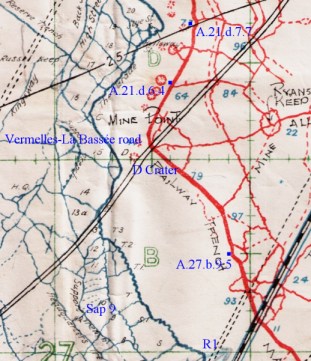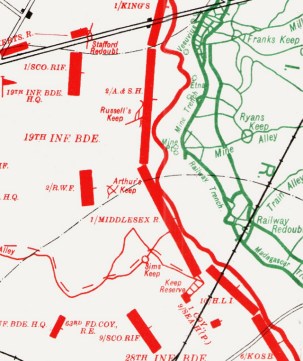 |
Homepage
Actions Maps More..... Mapping
notes
|
|
Preparations for the Battle of Loos30th June- 24th September 1915. For several reasons the Battle of Loos and the subsidiary operations connected therewith will always remain of special interest to the Middlesex Regiment. The first Victoria Cross awarded to the Regiment in the Great War was won by a gallant young officer-2nd Lieut. R. P. Hallowes, of the 4th Battalion-during the Second Attack on Bellewaarde (25th- 26th September); two "Service" Battalions (11th and 13th) for the first time took part in a set battle, therefore all Battalions of the Regiment then in France or Flanders (1st, 2nd, 3rd, 4th, 1/7th, 1/8th, 11th and 13th) were engaged in the main or subsidiary operations, and lastly the 1/8th Battalion, having resumed independent formation in August, once again held a portion of the front line. The official despatches may be searched in vain for the intentions of the Allied Commanders, which British and French troops, with the utmost gallantry, attempted to carry out with only partial success. Without going into a lengthy discussion of the general situation along the Western Front, which gave rise to the operations which began on 25th September and continued until the third week in October, the intentions of the Allies were briefly as follows:-(i) to break the enemy's front; (ii) prevent him re-establishing his line; (iii) to defeat decisively his divided forces. The British attack was to be carried out by the First and Second Armies operating practically along the whole front from just west of Loos to east of Ypres. The main attack was to take place from just east of the mining village of Grenay to Givenchy, north of the La Bassée Canal. In this attack two Corps, the 4th (3rd Cavalry, 1st, 15th and 47th Divisions), and 1st (2nd, 7th, 9th and 28th Divisions) (from right to left) were to take part, whilst the XIth Corps (Guards, 21st and 24th Divisions) was held in reserve. There were to be three subsidiary attacks (i) on the Moulin du Pietre by the Meerut Division of the Indian Corps (First Army); (ii) at Bois Grenier by the 8th Division, 3rd Corps (First Army); (iii) on Bellewaarde Farm by the 3rd Division (IVth Corps) and 14th Division (Vth Corps) of the Second Army. In the subsequent "Action of the Hohenzollern Redoubt," the 1st and 42nd Divisions (4th Corps) and Guards, 2nd, 12th and 46th Divisions-all First Army troops-were engaged. As already stated, every Battalion of the Middlesex Regiment then in France and Flanders fought in the Battle, i.e., either in the main or the subsidiary operations. The 1st Battalion (2nd Division), 3rd Battalion (28th Division), and 13th Battalion (24th Division) were engaged in the main operations. The 4th Battalion (3rd Division) attacked the enemy east of Ypres-at Bellewaarde -with the idea of holding him to his ground, whilst the 2nd, 1/7th and 1/8th Battalions of the 8th Division were similarly engaged at Bois Grenier; these were the subsidiary operations. The 11th Battalion (12th Division) was engaged in the subsequent Action of the Hohenzollern Redoubt. The main attack was to be made after asphyxiating gas had been discharged over the enemy's trenches. Massed artillery, numbering about 1000 guns, were to bombard the enemy's lines from Loos to La Bassée. Sir John French thus described the terrain of the battlefield to be: "The country over which the advance took place is open and overgrown with long grass and self-sown crops. From the Canal southward our trenches and those of the enemy ran roughly parallel, up an almost imperceptible rise to the south-west. From the Vermelles-Hulluch road southward the advantage of height is on the enemy's side as far as the Béthune-Loos road. There the two lines of trenches cross a spur in which the rise culminates, and thence the command lies on the side of the British trenches. Due east of the intersection of spur and trenches, and a short mile away, stands Loos. Less than a mile further south-east is Hill 70, which is the summit of the gentle rise in the ground." Other tactical features in the line were "Fosse 8"-a coal mine with a high and strongly-defended slag heap; the Hohenzollern Redoubt, a strong work thrust out nearly 500 yards in front of the German line, so that it came within a short distance of the British trenches, the "Quarries," situated west of Cite St. Elie, Hill 70, east of Loos and "Puits 14 Bis," another coal mine possessing great possibilities of defence, north of Hill 70. Between Loos and La Bassée, and situated well behind the German front line, were the villages of Cite St. Auguste, Hulluch, Cite St. Elie and Haisnes. The hour of attack for the Ist and IVth Corps was 6.30 a.m. on 25th September. Of the three Battalions of the Middlesex Regiment (1st, 3rd and 13th) engaged in the main operations, only the 1st attacked the enemy on the morning of "Z" day; the 3rd and 13th Battalions came into the line later. The 1st Middlesex since the last day of June had spent a comparatively quiet existence, either in billets in Grispot, near Steenwerck, or Laventie, or in the front line. Casualties were few, though in officers 2nd Lieut. B.O. Dewes was killed on 30th July, whilst out in front of the parapet. On the 15th August the 1st Middlesex were relieved by the 11th K.R.R. in the Laventie sector and moved back to billets. This was the last tour in the trenches in that part of the line, for on the 14th the 19th Infantry Brigade had issued orders to all units of the Brigade that after relief the troops would billet in the area Vieux Berquin- Neuf Berquin-Doulieu until 19th August, when the Brigade was to march to the Ist Corps area to replace the 4th (Guards) Brigade in the 2nd Division. Thus, once again, was the 19th Brigade transferred to another Division. At 8.30 a.m. all units of the Brigade set out on their march southwards to the new area. En route they passed the Windmill at Hinges, where Lord Kitchener and his staff were waiting by the roadside to see them go by, and from the congratulatory messages which subsequently reached all C.Os. it was evident that the march discipline, smartness and general turn-out of the Battalions pleased the Secretary of State for War. Between 2 and 3 p.m. the 19th Brigade marched into Béthune, where billets were speedily allotted to the Battalions. Inspection by the G.O.C. 2nd Division, on 20th, was followed by three days in billets, and then, on 24th, the Brigade took over the front-line trenches in the Cuinchy sector, the Middlesex being billeted in Annequin, with one company holding support points behind the trenches. The Battalion's first tour in the front line began on 27th August, but it only lasted three days, and on relief by the 2nd Royal Welch Fusiliers on 30th, the Middlesex returned to billets in Annequin, though holding posts at Annequin, Tourbières and Carter's and Braddell Redoubt. The early days of September were very quiet, and from the 6th to 11th special training was carried out in view of the coming operations. On the 23rd the 1st Battalion relieved the 2nd Royal Welch Fusiliers in the right sub-sector of the Cambrin sector. (The Cambrin sector apparently ran from a point R1 almost on the Vermelles- La Bassée railway north to Gun Street, which was just south of the Cambrin-La Bassée road. In co-ordinates the front line of the Brigade is expressed as from A.27.b.8.0. to A.21.d.4.9.) The latter was the right of the three sub-sectors held by the 2nd Division. On the right of the 1st Middlesex were troops of the 9th Division, and on the left the 2nd Argyll and Sutherland Highlanders. "Relieved the 2nd R.W.F. in Cambrin trenches at 5.30 p.m." records the Battalion Diary, and that is all; no description of the trenches, nothing (in view of the coming operations) of the preparations for the attack-no names, positions, or even co-ordinates. The trenches of the 1st Middlesex were apparently situated between the Vermelles-La Bassée railway and the Vermelles-La Bassée road. Behind the front-line trenches were support and reserve trenches, and in rear of the latter (in Lewis Alley) there was a fortified post named Sims Keep ; a similar post, some distance further back, called Lewis Keep, gave its name to Lewis Alley-a communication trench connecting Cambrin village (or ruins) with the front-line system. Sims Keep, Lewis Keep and Lewis Alley were, however, all inclusive to 9th Division, and therefore outside the 19th Brigade area. Final orders for the attack were issued on 24th September, so far as the 19th Infantry Brigade was concerned. The following are the principal points: the objectives of the Brigade were (1st) Les Briques Farm and Vermelles railway line as far N. as road crossing A.22.b.1.2 inclusive; (2nd) Auchy-lez-La Bassée and Triangle Alley from A.29.b.4.8 to A.23.a.6.2 (both inclusive) (3rd or main objective) railway line from B.25.b.7.7 (inclusive) to A.24.b.4.2 (exclusive). The objectives for the whole Brigade are given in order that the action of the 1st Middlesex might be more clearly understood: co-ordinates are unavoidable. The 1st Middlesex, on the right of the Brigade front, was to assault Railway Trench from A.27.b.9.5. to the Vermelles-La Bassée road. The 2nd A. and S. Highlanders, on the left of the Middlesex, were to capture Mine Trench from A.21.d.6.4 to A.21.d.7.7. As soon as the attacking Battalions had vacated their trenches, the 2nd Royal Welch Fusiliers were to occupy those previously held by the Middlesex, and the 1st Cameronians those lately occupied by the Highlanders. Trench co-ordinates. How to read a trench map.
In spite of the preliminary bombardment, which for several days had kept the enemy's trenches and wire under a continual hail of shell, the reports show that the wholesale destruction of the trenches to be assaulted and the wrecking of the thick wire entanglements in front of them had not been accomplished. For, on 24th, Lieut.-Colonel Rowley, commanding 1st Middlesex, reported to Brigade Headquarters that one of his patrol parties had been out in No Man's Land and had found that the wire behind the hostile craters was little damaged and was about 25 yards thick. The craters referred to in this report were great holes in No Man's Land, and often so close together that only a narrow path existed between them. The heavy rain had made these paths greasy and thick in mud, whilst the "going" generally across the dread space between the opposing lines was difficult. Thus the attacking troops were confronted not only by formidable positions, but would have to make their assault across ground deep in mud and broken by shell and mine craters. Throughout the night of 24th-25th September, final preparations were made, and, at 3.30 a.m. on the latter date, the Brigade reported that all units were in positions of assembly in the trenches south of the La Bassée road from Gun Street to R.1; the Middlesex on the right holding from R.1 to D crater, and the Highlanders from the latter to Gun Street. "Zero" hour had been postponed to the last possible moment, but during the night it had been definitely fixed for 5.50 a.m., when the gas projection was to take place and smoke candles burned. Go to Battle of Loos or Back to list of actions |
|||
|

